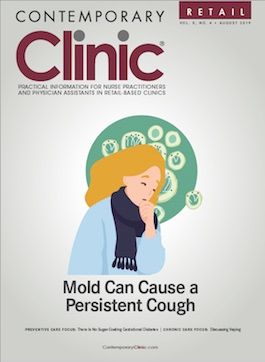Mold Can Cause a Persistent Cough
Exposure to damp and moly environments may also result in a variety of other health issues.
Cladosporium, Penicillium, Alternaria,andAspergillusare the most common molds found in almost all environment.1These are just a few of the hundreds of thousands of species of fungi. Molds grow in damp, warm, areas and are spread by spores both indoors and outdoors. People are typically exposed to mold by contact, ingestion, or inhalation. The most common places to find mold indoors are bathrooms, kitchens, and basements. (And don't forget that loaf of bread that has been sitting on the counter for too many days.) Outside, mold may reside in compost piles of hay, leaves, or vegetation or in damp, shady areas. Keep in mind that the higher the humidity, the more conducive the environment is to mold, and stirring up mold can send the spores into the air.
In 2004, the Institute of Medicine (IOM) found evidence linking mold exposure to coughing, upper respiratory tract symptoms, and wheezing in healthy people, with asthma symptoms in individuals with asthma and hypersensitivity pneumonitis in those with weakened immune systems.2Some people are sensitive to mold exposure and can exhibit symptoms, such as itchy or red eyes, skin irritation, and a stuffy nose.1Further, those with chronic respiratory disease may experience difficulty breathing. Results of a study by National Institute of Environmental Health Sciences (NIEHS)-funded scientists showed that mold exposure in the first year of life may increase the risk of childhood asthma.3Inhaling mold spores may cause allergic reactions, most commonly from July to early fall, but because mold grows both indoors and out, allergic reactions can occur year-round.4Symptoms may include coughing, shortness of breath, and wheezing. For patients with allergies, clinicians can perform skin tests or allergen-specific immunoglobulin E blood tests to identify a mold allergy. Antihistamines and nasal steroids are available over the counter to help reduce nasal itching and other symptoms. For patients with allergic asthma, clinicians may consider allergy shots and/or an inhaler. Importantly, however, remember that reducing exposure is really the key.
The type of mold that seems to generate the most attention isStachybotrys chartarum, also known as black mold. How common is black mold, the toxic mold that everyone fears?
It is rare, according to the CDC.
Results of some studies have suggested that exposure to water-damaged building materials withS chartarummay be associated with idiopathic pulmonary hemorrhage (IPH) in infants, sick building syndrome, and toxic inflammatory effects in workers.5Few toxicologic data were available, and the need for studies evaluating potential toxicity from long-term exposure was indicated.
After many toxicologic studies, the CDC concluded that evidence does not support a causative relationship between exposure toS chartarumand IPH in infants, intensification of asthma, or sick building syndrome, and the IOM committee drew the same conclusion.5
Given that almost everyone is exposed to mold every day and everywhere, is it necessary to run testing to determine the type of mold found in the environment? The CDC does not recommend general or routine sampling for molds to identify the species, as allergies are the conditions most often associated with mold.1Patients must be aware of measures to reduce exposure. This, in turn, will help reduce symptoms.
The CDC offers these specific recommendations1:
- Clean bathrooms with mold-killing products.
- Do not carpet bathrooms.
- Ensure adequate ventilation, including exhaust fans, in the bathroom and the kitchen.
- Keep indoor humidity levels low, at less than 50% all day.
- Remove and replace flooded carpets.
- Use an air conditioner or a dehumidifier during humid months.
- Use mold inhibitors, which can be added to paints.
Flooding, hurricanes, and tropical storms have drawn national attention to ensuring the safety of workers volunteering to help with the cleanup of damp, flooded areas and buildings Recovery workers are encouraged to use personal protective equipment to minimize exposure, reducing health problems such as allergies, dermatitis, and respiratory symptoms. The NIEHS Worker Training Program has provided safety training to workers in disaster and emergency response for more than 15 years, including resources and tools aimed at protecting their health and safety.7Importantly, all response and recovery workers must be familiar with these recommendations to ensure their personal safety.
CONCLUSION
Exposure to mold is inevitable in almost all environments. Individuals with an allergy or sensitivity to mold may incur symptoms that can include a cough. The solution is to avoid unnecessary exposure and use the resources and tools provided by organizations such as the CDC and the NIEHS to promote safety and proper cleanup.
REFERENCES
- Molds in the environment. CDC website. cdc.gov/mold/faqs.htm. Updated December 20, 2017. Accessed July 9, 2019.
- Facts about mold and dampness. CDC website. cdc.gov/mold/dampness_facts.htm. Updated September 17, 2017. Accessed July 9, 2019.
- Mold. National Institute of Environmental Health Sciences website. niehs.nih.gov/health/topics/agents/mold/index.cfm. Updated December 28, 2018. Accessed July 9, 2019.
- Johanning E, Auger P, Morey PR, Yang CS, Olmsted E. Review of health hazards and prevention measures for response and recovery workers and volunteers after natural disasters, flooding, and water damage: mold and dampness.Environ Health Prev Med.2014;19(2):93-99. doi:10.1007/s12199-013-0368-0.
- Mold allergy. Asthma and Allergy Foundation of America website. aafa.org/mold-allergy/. Updated October 2015. Accessed July 9, 2019.
- Stachybotrys chartarum(orS. atraorS. alternans) [CAS No. 67892-26-6]: review of toxicological literature. National Toxicology Program website. ntp.niehs.nih.gov/ntp/htdocs/chem_background/exsumpdf/stachybotrys_508.pdf. Published June 2004. Accessed July 9, 2019.
- All-hazards resources. National Institute of Environmental Health Sciences website. tools.niehs.nih.gov/wetp/index.cfm?id=2569. Accessed July 9, 2019.

